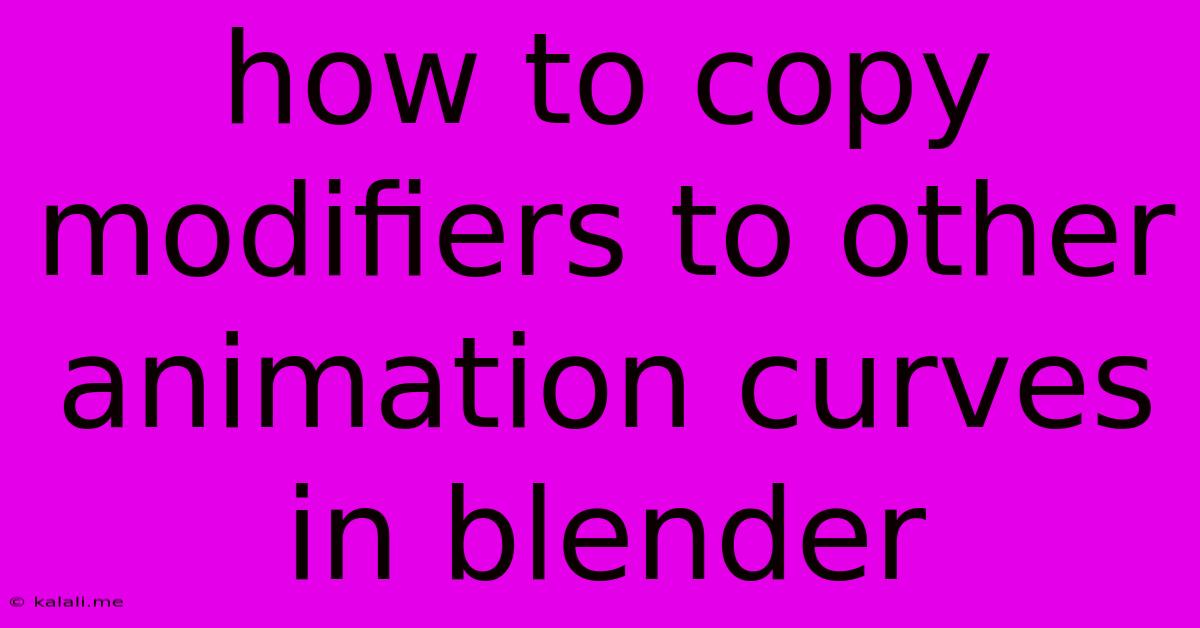How To Copy Modifiers To Other Animation Curves In Blender
Kalali
May 23, 2025 · 3 min read

Table of Contents
How to Copy Modifiers to Other Animation Curves in Blender
This guide provides a comprehensive walkthrough on efficiently copying modifiers from one animation curve to others in Blender. This is incredibly useful for maintaining consistency across multiple animations, saving you significant time and effort. We'll cover several methods, catering to different workflows and levels of expertise.
Meta Description: Learn how to effortlessly copy modifiers between animation curves in Blender, streamlining your workflow and saving valuable time. This guide covers multiple methods for efficient animation management.
Understanding Animation Modifiers in Blender
Before diving into the copying process, it's crucial to understand what animation modifiers are. These are tools that allow you to manipulate your animation curves non-destructively. They range from simple operations like scaling and offsetting curves to more complex functionalities like noise and cycles. Copying these modifiers ensures consistency in your animations, crucial for things like character rigging or complex scene setups.
Method 1: Using the "Copy Animation Data" Function
This is the simplest and most direct method for copying modifiers. It works particularly well if you're copying modifiers between similar animation curves of the same object or even between different objects:
- Select the Source Object: Choose the object with the animation curves containing the modifiers you want to copy.
- Select the Target Object(s): Select the object(s) where you want to apply the copied modifiers. Hold Shift to select multiple objects.
- Open the "Copy Animation Data" Menu: Go to the "Dope Sheet" editor or the "Graph Editor." Right-click and select "Copy Animation Data."
- Choose the Appropriate Options: In the pop-up menu, ensure that "Modifiers" is checked. You can also select other animation data to copy, depending on your needs. Be mindful of "Clear Existing" checkbox, it will override any existing animation.
- Apply: Click "Copy Animation Data." The selected modifiers will now be applied to the target animation curves.
Advantages: Quick, straightforward, and ideal for similar animations. Disadvantages: Can be less precise if dealing with drastically different animation curves.
Method 2: Manual Modifier Copying and Pasting
This offers more granular control, allowing you to selectively copy specific modifiers:
- Select the Source Curve: In the "Dope Sheet" or "Graph Editor," select the animation curve with the modifier you want to copy.
- Access the Modifier Properties: In the Properties panel, go to the "Modifiers" tab.
- Copy the Modifier: Right-click on the modifier and select "Copy."
- Select the Target Curve: Select the target animation curve where you want to add the modifier.
- Paste the Modifier: Right-click and select "Paste."
- Repeat for all Modifiers: Repeat steps 3-5 for every modifier you want to copy.
Advantages: Precise control over which modifiers are copied. Disadvantages: Time-consuming for animations with many modifiers.
Method 3: Using Animation Constraints (for advanced users)
For more complex scenarios, using animation constraints can be a powerful approach. This method is more advanced and requires a deeper understanding of Blender's constraint system. This method works best when there is a relationship already set up between the source and target object(s). It lets you maintain a dynamic connection. The specific constraint to use will depend on your animation needs.
Advantages: Maintains a dynamic link, updates automatically if source animation changes. Disadvantages: More complex setup than other methods.
Choosing the Right Method
The best method depends on your specific needs and the complexity of your animation. For quick, straightforward copying between similar animations, the "Copy Animation Data" function is ideal. For precise control over individual modifiers, manual copying and pasting is recommended. For complex, dynamic relationships between animations, animation constraints offer the most powerful solution.
By mastering these techniques, you'll significantly enhance your animation workflow in Blender, improving efficiency and consistency across your projects. Remember to save your work frequently to prevent accidental data loss.
Latest Posts
Latest Posts
-
Water Coming Out Of Exhaust While Idling
May 23, 2025
-
Are The Jews Still Gods Chosen People
May 23, 2025
-
If You Have More Questions
May 23, 2025
-
How Do Organic Material Impat Acid Dissolution
May 23, 2025
-
Stepper Motor Soem Does Not Work Control Frequency
May 23, 2025
Related Post
Thank you for visiting our website which covers about How To Copy Modifiers To Other Animation Curves In Blender . We hope the information provided has been useful to you. Feel free to contact us if you have any questions or need further assistance. See you next time and don't miss to bookmark.